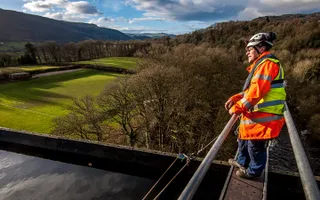Hello, I'm Simon Turner, I'm the national workshop manager for the Canal & River Trust. I'd like to welcome you to Bradley Workshop here in the West Midlands. This is one of the two sites that we have where we make lock gates for the Canal & River Trust with the other one being Stanley Ferry Wakefield here in Yorkshire.
What I'd like to do is take you through a tour of how lock gates are made, the processes, the tools, the equipment and everything else involved. So every year the Canal & River Trust will change up to 150 lock gate leaves. That process will start 18 months in advance where we identify which gates need to be changed.
The next steps will be lock gate technicians going out to each site and taking measurements and surveys of those lock gates to understand the requirements. After that, they'll be transferred into the drawing department where accurate detail plans are produced which allow the gates to be made. Once that has happened we produce a cutting list.
The cutting list is of the timber that is required to make the gates. So we'll take you through now and show you that process. The first step of the process, really the most important part, is us carrying out and doing the surveys of the lock gates. The purpose of that is for us to check measurements against existing drawings, but things have changed over 25 to 30 years.
So we don't just want to rely on that old drawing, we want to go and check on site. They'll use the drawing, how the gates sit, and take new measurements to come up with the survey. As you can see, it's quite technical. The tools that they'll use to do this are really basic, and the reason we do it this way is to reduce the cost of dewatering the lock but also minimize the impact on our customers.
To do it in the dry, we'd have to dewater the lock at a huge cost, causing additional stoppages. One of the main tools is a staff with a foot on the bottom, used to measure from the sill to the collar hole. This can be challenging because obstacles like bricks or blocks might be at the bottom of the canal, so we have to ensure accurate positioning. Workers wear harnesses to prevent falls into the canal.
Another aspect to consider is the pitch of the gates. Lock chamber walls are never straight, plumb, or level, so we need to measure the angle of the walls. This is done manually by leaning over the lock edge with a level, which isn't ideal but ensures precision. Over 30 separate measurements are taken for each lock gate leaf, including the collar hole, the length of the buns beam, and the angle of the mitre gates.
To improve safety and accuracy, we have invested in laser-pointing equipment. This technology allows precise measurement of angles and dimensions, which can be transferred into CAD (computer-aided design) packages. This investment is crucial for the future of lock gate production.
This is the drawing office at Bradley Workshop. Once the site survey is completed, all the information is processed and drawn in CAD. For a long time, we relied on 2D CAD, which produced flat drawings with limited information. We are now transitioning to 3D modeling. This allows us to manipulate, turn, and check the gates to ensure they fit the specific lock chambers they are designed for. Any errors would render them unusable elsewhere.
The next steps include moving toward CNC (computer numerically controlled) production. We've already begun with plasma cutters and are planning further investments in CNC machinery. Producing 150+ lock gate leaves annually is a significant task requiring detailed design and modeling before moving to production.
The gates start with green timber, primarily English and Scottish oak, which arrives in a rough-cut state. The first step is planing the timber, not to smooth it like joinery but to square and true it for gate construction. This is done using an old two-sided planing machine, although only one side is operational.
The timber is then cut to length using a large saw, emphasizing safety. The joints are constructed using mortise and tenon techniques. A tenon machine forms the tenons efficiently, and mortises are created using 1950s-era machines. These involve drilling square holes with chisels and augers. Green oak is used because kiln-dried oak is cost-prohibitive and impractical.
After machining, the assembly process begins. Despite the heavy timbers, finesse is required, and specialized tools like large chisels, lump hammers, and custom-made implements are used. We've also transitioned to battery-powered tools, such as 40-volt impact drivers and electric chainsaws, for safety and efficiency within the workshop.
The tools and equipment required are extensive, with each workshop using over £100,000 worth of tools. Much of the machinery dates back to the 1950s, and we are now investing in modern CNC technology as the next evolutionary step.
Lock gate components include timber, gears, brackets, and other fittings. These are produced in-house, with some parts, like hinges and gearing, unique to specific canals. For example, BCN and Trent and Mersey canals have distinct styles. Recycled components are also used where possible to reduce costs.
Our plasma cutter, a recent investment, allows us to produce components like brackets and fender plates in-house, reducing costs significantly. Previously purchased parts now cost a fraction to produce, with the machine paying for itself within a year.
Once the gates are completed, they are stored outside and kept wet to prevent drying and warping. The final installation process includes transporting the gates, beams, and components to their destination.
Producing lock gates is a complex and expensive process, with costs ranging from £16,000 for basic gates to over £100,000 for larger river gates. Regular replacement of lock gates is essential to keep canals operational, making this a vital part of the Canal & River Trust's work.






